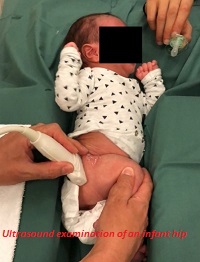Developing a new screening program for developmental dysplasia of the hip
Each year 300 patients are surgically treated in Denmark for conditions relating to late- or undiagnosed developmental dysplasia of the hip (DDH).
This project seeks to prevent such cases by developing a cost-effective screening program which leads to better diagnostics and earlier and less invasive treatment.
DDH is a condition characterized by underdevelopment of the hip joint, which leads to mechanical instability, delayed walking, pain when walking and ultimately complete joint dislocation and early hip arthrosis if left untreated. The condition affects approximately 1% of all newborn children, which makes it the most common cause of referral to orthopaedic paediatric consultation.
Early diagnosis is of great importance as nearly all cases can be treated with a simple cast or brace if the child is below 6 months of age. As the child grows older, the need for surgical intervention and risk of complications increases.
As a result, a DDH screening programme for all children has been implemented in Denmark. The screening consists of a clinical examination of all children and an ultrasound examination of the hip performed by a specialized radiologist for selected at-risk children. Evidence is increasingly pointing towards the ineffectiveness of this approach, as we now know that this method generally does not detect children who later go on to need surgical treatment and, alarmingly, 35 years of screening in the UK using this method has not had an effect on children who go undetected with DDH.
"[Current] screening for hip dysplasia has proven inadequate and outdated"

Excerpt from review of current Danish screening for DDH. Danish Medical Journal 2020
We know that hip ultrasound examination of all children is effective in reducing undetected DDH and it allows us to treat earlier and more effectively. But the increased cost of having specialized radiologists perform hip ultrasound examinations of all children makes this screening method difficult to implement in a hospital system where resources are increasingly scarce.
In 2013 a new ultrasound examination method was proposed using the Pubo Femoral Distance (PFD). The PFD method is easy to learn for examiners, requires no previous experience with ultrasound examination and we have since documented that it is highly effective in detecting DDH. This makes it an ideal tool for a cost-effective ultrasound screening programme, as it does not depend on using specialized radiologists.
The time has now come to test the method in clinical practice
In this project we will implement an ultrasound screening programme of all newborn children born at Aarhus University Hospital during a 1-year project period using the PFD method with the midwives as examiners. All children will be offered the opportunity to have this examination done in addition to the current screening for DDH. The examination will take place immediately after their already scheduled visit to the midwife clinic 2-4 days after birth. The examination is risk free, painless and requires no additional hospital visits. If the PFD examination shows signs of DDH, the child will be referred to a specialized radiologist for further ultrasound examination similarly to the existing screening program.
During the project we will evaluate the new method of screening and document the learning process for the examining midwives. We aim to show this method as a cost-effective alternative to the current screening and that the method is easily implementable in the hands of novice ultrasound users.
It is our goal that no child should undergo surgery because of undiagnosed childhood DDH, and if the PFD method proves effective, to implement a national screening program for DDH where every child will be offered an ultrasound examination of their hips in the future.
Hans-Christen Husum

Hans-Christen Husum
Project manager, MD, PhD research fellow.
Interdisciplinary Orthopaedics
Aalborg University Hospital
h.husum@rn.dk
Opdateret


